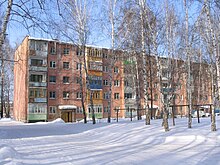Khrushchevka

Khrushchevka ( Russian хрущёвка ) is a colloquial term used in Russia and other successor states of the Soviet Union for a five-storey prefabricated building mostly built in the 1960s or 1970s . Once upon a time, such tenement houses were built en masse on the approval of Nikita Khrushchev (hence the name) for the common people in cities and settlements of the urban type in order to eliminate the shortage of housing as quickly and cost-effectively as possible. Due to their cheap construction and the associated low level of living comfort, the houses are often referred to as Khrushchoba (Russian хрущоба , a play on words or suitcase word from Хрущёв ( Khrushchev ) and трущоба ( Truschtschoba = slum )).
particularities
A Khrushchevka is not understood to mean every prefabricated building, but a type of prefabricated building typical of its time, which due to its relatively cheap construction has a number of special features, most of which have a negative effect on the quality of living. These characteristics are mainly the following:
- The building material of a Khrushchevka are mostly precast concrete slabs ("slabs" construction in the narrower sense), but sometimes also bricks , - in the latter case the living comfort and the useful life of the building are slightly higher than is generally the case with concrete structures;
- The houses have five (more rarely: three or four) floors including the ground floor and no attic ;
- The houses do not have an elevator ;
- The ceiling height in the apartments is only 2.5 meters (compared to the three to four meters customary for buildings of socialist classicism );
- Very low heat and sound insulation of the exterior and interior walls.
History of origin

The forced collectivization and industrialization of the Soviet Union in the 1930s and the resulting massive rural exodus , but also the destruction during the Second World War, led to a devastating housing shortage in all Soviet cities , from which larger families in particular suffered. Because of the shortage of housing, ordinary citizens had to be content with one room in the so-called communal kas, a kind of “forced community apartments ” in which a kitchen, a bathroom and a toilet were usually provided for use by several families. The huge and steadily growing need for living space could not be met with the previously practiced, massive construction.
With the invention of “the” cheap tenement barracks for the little man out of this great need, the prefabricated building was born in the mid-1950s. The design of the simple, unitary building goes back to the engineer and Shtusev student Vitaly Lagutenko . In 1955 the Council of Ministers of the USSR gave the green light for prefabricated buildings in the Soviet Union with its decree "On the development of housing construction in the USSR". The first Khrushchevkas were built in 1958 in Moscow's new Cherjomuschki district , where an entire residential area with the new five-story new buildings was built on an experimental basis on the site of a former village. A few years later the construction of similar residential areas began in all other regions of the country.
In the beginning, the new living space was still in great demand, since an own apartment - regardless of the quality - was still a rarity for a simple Soviet citizen of that time. The Khrushchevkas only received their derogatory designation decades later, when the quality of the prefabricated building had generally increased considerably and living space was no longer quite as scarce. In isolated cases, however, Khrushchevkas were still being built into the 1980s.
present
In what is now Russia, a total of 290 million m² of living space in the form of Khrushchevkas was built during the Soviet era. A significant part of it is still in use today and makes up around 10 percent of the country's total living space. The problem here is that many Khrushchevkas were intended as a kind of temporary solution at the time of their creation, so that their expected useful life should only be around 20 years. According to this, many of the Khrushchevkas still in use today have significantly exceeded their lifespan and pose a danger to their residents, not to mention their low and long outdated quality of living and mostly also the clearly visible external decay.
In Moscow and some other cities, efforts have been increasing in recent years to demolish the oldest Khrushchevkas and to move their residents into newly built replacement apartments. However, poorer cities can hardly afford this financially, so that the Khrushchevkas will be part of the cityscape there for the time being.
